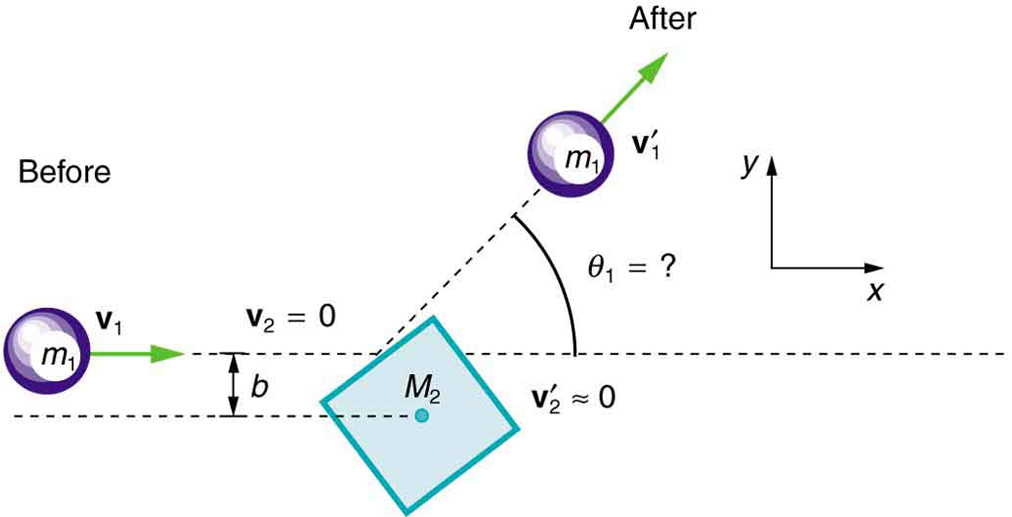| << Chapter < Page | Chapter >> Page > |
[link] shows a cube at rest and a small object heading toward it. (a) Describe the directions (angle ) at which the small object can emerge after colliding elastically with the cube. How does depend on , the so-called impact parameter? Ignore any effects that might be due to rotation after the collision, and assume that the cube is much more massive than the small object. (b) Answer the same questions if the small object instead collides with a massive sphere.

Two identical pucks collide on an air hockey table. One puck was originally at rest. (a) If the incoming puck has a speed of 6.00 m/s and scatters to an angle of ,what is the velocity (magnitude and direction) of the second puck? (You may use the result that for elastic collisions of objects that have identical masses.) (b) Confirm that the collision is elastic.
(a) 3.00 m/s, below -axis
(b) Find speed of first puck after collision:
Verify that ratio of initial to final KE equals one:
Confirm that the results of the example [link] do conserve momentum in both the - and -directions.
A 3000-kg cannon is mounted so that it can recoil only in the horizontal direction. (a) Calculate its recoil velocity when it fires a 15.0-kg shell at 480 m/s at an angle of above the horizontal. (b) What is the kinetic energy of the cannon? This energy is dissipated as heat transfer in shock absorbers that stop its recoil. (c) What happens to the vertical component of momentum that is imparted to the cannon when it is fired?
(a)
(b)
(c) The ground will exert a normal force to oppose recoil of the cannon in the vertical direction. The momentum in the vertical direction is transferred to the earth. The energy is transferred into the ground, making a dent where the cannon is. After long barrages, cannon have erratic aim because the ground is full of divots.
Professional Application
A 5.50-kg bowling ball moving at 9.00 m/s collides with a 0.850-kg bowling pin, which is scattered at an angle of to the initial direction of the bowling ball and with a speed of 15.0 m/s. (a) Calculate the final velocity (magnitude and direction) of the bowling ball. (b) Is the collision elastic? (c) Linear kinetic energy is greater after the collision. Discuss how spin on the ball might be converted to linear kinetic energy in the collision.
Professional Application
Ernest Rutherford (the first New Zealander to be awarded the Nobel Prize in Chemistry) demonstrated that nuclei were very small and dense by scattering helium-4 nuclei from gold-197 nuclei . The energy of the incoming helium nucleus was , and the masses of the helium and gold nuclei were and , respectively (note that their mass ratio is 4 to 197). (a) If a helium nucleus scatters to an angle of during an elastic collision with a gold nucleus, calculate the helium nucleus’s final speed and the final velocity (magnitude and direction) of the gold nucleus. (b) What is the final kinetic energy of the helium nucleus?
(a) at
(b)
Professional Application
Two cars collide at an icy intersection and stick together afterward. The first car has a mass of 1200 kg and is approaching at due south. The second car has a mass of 850 kg and is approaching at due west. (a) Calculate the final velocity (magnitude and direction) of the cars. (b) How much kinetic energy is lost in the collision? (This energy goes into deformation of the cars.) Note that because both cars have an initial velocity, you cannot use the equations for conservation of momentum along the -axis and -axis; instead, you must look for other simplifying aspects.
Starting with equations and for conservation of momentum in the - and -directions and assuming that one object is originally stationary, prove that for an elastic collision of two objects of equal masses,
as discussed in the text.
We are given that . The given equations then become:
and
Square each equation to get
Add these two equations and simplify:
Multiply the entire equation by to recover the kinetic energy:
Integrated Concepts
A 90.0-kg ice hockey player hits a 0.150-kg puck, giving the puck a velocity of 45.0 m/s. If both are initially at rest and if the ice is frictionless, how far does the player recoil in the time it takes the puck to reach the goal 15.0 m away?

Notification Switch
Would you like to follow the 'College physics' conversation and receive update notifications?